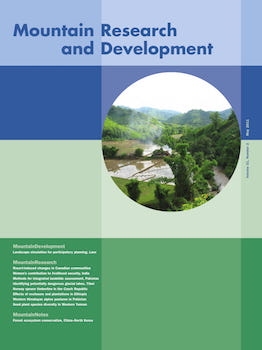Dear Readers,
The present issue of MRD is an “Open Issue,” offering a range of articles on topics of concern in mountain areas around the world. The papers take up current global debates such as food and economic security, biodiversity conservation, and risk management. In the MountainDevelopment section, Jeremy Bourgoin and Jean-Christophe Castella contribute “transformation knowledge” to a topical debate in the Lao PDR: how can farmers at the local level be effectively integrated in present-day land use planning processes and gain sufficient understanding of the economic and ecological dynamics that affect future land use options? In the Lao PDR, the national government is dealing with powerful global economic trends and global mechanisms for conserving rich natural resources in remote mountain areas, while at the same time involving local communities in land use planning processes. The approach described by Bourgoin and Castella is an interesting means of enhancing these endeavors.
The effects of land use plans on people's livelihoods and the environment are also at the core of the first paper in the MountainResearch section: Sanjay Nepal and Tazim B. Jamal present a comparative study of internal and external pressures triggered by amenity migration on 5 mountain resorts in British Columbia, Canada. They underline the need for local participation and a more integrated perspective to avoid the pitfalls of one-sided development. In a completely different context, in the Garhwal Himalayas in India, Shiv Sidh and Sharmistha Basu also draw attention to the importance of local actors' perspectives in development: they analyse women's contribution to household food and economic security—a source of community wealth that is generally ignored in calculations of economic systems. Involvement of local actors is also seen as one of the keys to making risk assessments bear their fruit: Karen Sudmeier-Rieux, Michel Jaboyedoff, Alain Breguet, and Jérôme Dubois present the results of applying an integrated landslide assessment framework in a severely earthquake-affected valley of northern Pakistan.
Weican Wang and coauthors introduce a risk assessment method for potential large-scale natural hazards: they focus on a cost-effective way of evaluating the danger of glacial lakes bursting in a region of the southeastern Tibetan Plateau. The next 4 papers offer valuable insights on mountain vegetation in different parts of the world: Martin Šenfeldr and Petr Maděra analyze regeneration aspects of Norway spruce growing above the former pastoral timberline in the Hrubý Jesenik Mountains, Czech Republic. Abrham Abiyu and coauthors present a comparative study of the effects of 2 methods used for restoring degraded lands in tropical semiarid areas—exclusion of grazing animals and tree plantations—in northern Ethiopia. Hamayun Shaheen, Shujaul Mulk Khan, and David M. Harper are concerned by the status of biodiversity-rich but fragile western Himalayan pastures, and describe species distribution patterns, richness, similarity, and community structure of selected pastures in Azad Kashmir, Pakistan. Finally, Rong Li, Zhiling Dao, and Heng Li present the results of a long-term botanical survey in the extraordinarily rich northern Gaoligong Mountains of western Yunnan, China.
A similar concern for biodiversity also drives the MountainNotes paper by Lina Tang, Aixian Li, and Guofan Shao. They describe what anthropogenic factors, including deforestation, logging, nonwood product collection, and tourism, threaten forest sustainability inside and around protected areas on Changbai Mountain, eastern China, and propose transboundary agreements and an approach to relieve the pressure on these protected areas.
In the MountainPlatform section, MRD features an article by a new institutional member of the International Mountain Society (IMS)—the Centre for Mountain Studies (CMS) at the University of the Highlands and Islands in Scotland. CMS Director Martin Price is also MRD's MountainMedia Editor. His role in support of sustainable mountain development at the global level is undisputed. By becoming a member of the IMS, his institution joins the 9 other IMS institutional members in helping to provide sound evidence on mountains and sustainable development for next year's Rio +20 process.
We wish our readers interesting insights from the work presented in this issue.





